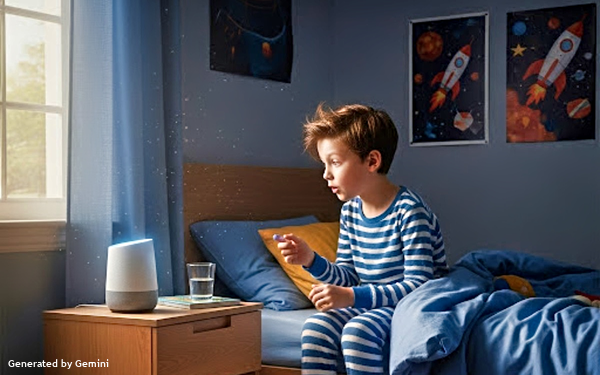
Advertisers spend millions trying
to decode consumer media habits. But what happens when the next generation doesn’t even know what their media consumption habits are?
That’s the case with Gen Alpha.
As a proud dad of a 7-year-old, I can confirm my son couldn’t explain media consumption, but he definitely has preferences: “Netflix and YouTube.” He’s also glued to
my phone the second he hears a supercar rev on Instagram.
As a parent and agency exec, I find this fascinating. Gen Alpha is shaping a future where ads aren’t just
ignored, they’re avoided. And the old media playbook? It’s already starting to feel prehistoric.
My Daily Media Diet (According to a
7-Year-Old)
“Alexa, did the Mavs win?” That’s usually what I hear from my son’s room when he wakes up in the morning. Usually followed by
“Alexa, what’s the weather?” or “Alexa, what time is it?”; the former for when he wakes up early, the latter when he knows he’s going to be late for school. On more
days than not, his first interaction is with an AI voice assistant before a human being. While slightly offended, I understand it. After all, Alexa has more answers than I do.
advertisement
advertisement
Like
many millennials, I’ve always prided myself on being digital first. Perhaps this digital-first approach is in my DNA and my son inherited it.
While eating, he either watches
NBA game highlights or Carwow drag racing videos on YouTube. While this is his version of the “feed during the feed”, it’s also serving as his mental queue for what to watch later.
Quite the sly multitasker! Our TV time post dinner isn’t focused around which show to watch, but rather which game to watch on NBA League Pass.
“What’s Cable?”
When I tell my son he’s lucky to have all of this content at his fingertips, he’s quite perplexed.
“They didn’t have YouTube in the 19’s?” (that’s what he calls the 1900s, which makes me feel even older than I am!).
He’s shocked when I
tell him that YouTube wasn’t a thing when I was his age. We had to wait for Saturday morning to come around to watch our favorite cartoons. The concept of having to wait for pre-recorded content
doesn’t register in his brain. In his world, bingeing is the norm.
It’s a byproduct of the dominance of short-form videos in today’s world of content. ‘Reels’ this
and ‘Shorts’ that. Getting him to watch a long-form piece of content (>10 minutes) is a struggle. Unless, of course, it’s Mr. Beast who can make a 3-hour video feel like a
30-second Reel with all the hooks and rollercoaster rides.
My Attention Span Is Fine…Sort Of
A commonly repeated sentiment is that Gen
Alpha have short attention spans. That’s not exactly true. My son will watch an entire NBA game or binge highlights as long as the content moves fast enough, stays dynamic, and feels
interactive. Even with short videos, he’ll skip 2-minute clips if the cars don’t excite him or the presenter is boring. As a huge soccer fan, I’ve tried to share games with him, but
they’re too slow for his taste. NBA keeps him engaged with constant motions. Until the ads come on. That’s when the frustration begins.
What I Like
(and What I Don’t)
I cut cable, but ads still sneak into our house, mostly through YouTube. By the time my son was 5, he could read the ‘Skip Ad’ button
and has hated interruptions since. Can’t blame him. Even I, someone who works in the industry, don’t like ones that disrupt the experience.
He’ll power through ads
if he really wants the content, though every so often, the ads hit just right. Like when a Hot Wheels spot follows a Ferrari video, suddenly, he’s asking if I can find that exact toy. But
that’s rare. Most ads? Irrelevant, annoying, and skipped fast.
The Future (As Seen Through His Eyes…and Mine)
Simply put, ads
ruin the viewing experience. But ads also make content accessible for free. That’s the tradeoff. You spend $200 a month on every streaming service to avoid them, but live TV, Instagram, Tik Tok?
Still packed with ads. There’s no real way around to fully opt out. From a candid 7-year-old’s point-of-view: “ads suck!” And he’s not wrong.
Brands have
prioritized volume over quality, and platforms have created endless placements to chase attention. Instead of value, we’ve ended up with clutter and Gen Alpha isn’t likely to tolerate that
for long. We’re already seeing signs of pushback with Gen Z.
The future is already forming via creator-driven content. When a product is baked into the story, it doesn’t feel like
an ad. It feels like entertainment. These creators don’t need to be famous - niche voices drive real engagement. They don’t even need to be human.
With tools like Google’s Veo
and the rise of AI influencers, the next wave of advertising may not look like advertising at all.
Conclusion: Show Up Where It Matters
This
new era of ads isn’t revolutionary, according to my son. It should just be the norm. How viewing experiences were meant to be.
After all, you don’t go to a ballgame
and find someone trying to sell you hair loss pills or a timeshare in the Everglades. At least I’d hope not. So why can’t that same experience be true in the digital world? That is what
the expectation is turning out to be for Gen Alpha, the next generation of consumers.
So as marketers, the challenge isn’t just to "reach" Gen Alpha — it’s to
belong where they already are in a true and authentic self.
It’s to show up in ways that respect their time, enhance their experience, and maybe even make them smile. Perhaps through that
smile, they’ll be so intrigued and entertained that maybe they’ll even forget they are watching an ad.